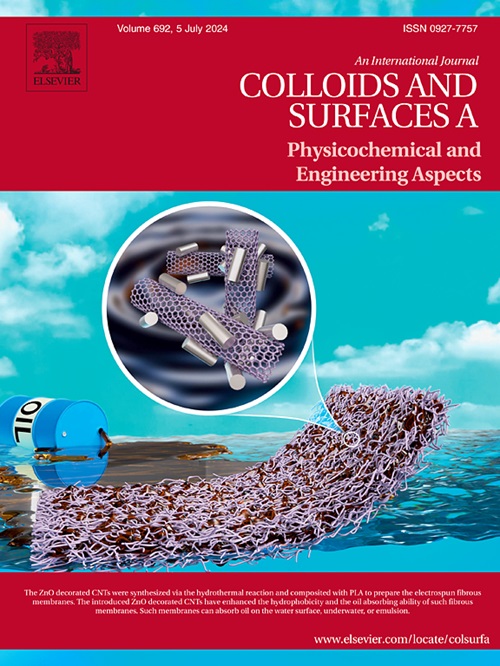Multifunctional MnO2-based nanoplatforms for mitigation of hypoxia and achieving self-enhanced diagnosis and treatment of liver cancer
IF 5.4
2区 化学
Q2 CHEMISTRY, PHYSICAL
Colloids and Surfaces A: Physicochemical and Engineering Aspects
Pub Date : 2025-07-16
DOI:10.1016/j.colsurfa.2025.137757
引用次数: 0
Abstract
In solid tumors, chronic lack of blood and oxygen (O2) causes hypoxia, which diminishes tumor cell sensitivity and contributes to unfavorable outcomes. To address this issue, we synthesized manganese dioxide MnO2 on gold nanorods (GNR), a system designed to undergo straightforward degradation within the tumor microenvironment (TME). The nano platform facilitates the controlled release of drugs within the TME and mitigates hypoxia to enhance photodynamic therapy for hepatocellular carcinoma. The unique mesoporous structure of the nanoplatforms allows for the loading of indocyanine green (ICG) and Doxorubicin (DOX), which serve as near-infrared (NIR)-mediated photodynamic reagents. When applied to hepatocellular carcinoma, MnO2 rapidly degrades within the TME, efficiently releasing DOX and ICG. Additionally, the agent induces the decomposition of endogenous hydrogen peroxide abundant in hepatocellular carcinoma, thereby facilitating highly efficient chemo/photothermal/photodynamic therapy.
多功能二氧化锰纳米平台缓解缺氧和实现自我增强诊断和治疗肝癌
在实体瘤中,长期缺乏血液和氧气(O2)导致缺氧,从而降低肿瘤细胞的敏感性并导致不良后果。为了解决这个问题,我们在金纳米棒(GNR)上合成了二氧化锰MnO2,这是一种在肿瘤微环境(TME)中进行直接降解的系统。纳米平台促进药物在TME内的控制释放,减轻缺氧,以增强肝细胞癌的光动力治疗。纳米平台独特的介孔结构允许负载吲哚菁绿(ICG)和阿霉素(DOX),作为近红外(NIR)介导的光动力试剂。当应用于肝细胞癌时,MnO2在TME内迅速降解,有效释放DOX和ICG。此外,该药物诱导肝细胞癌中丰富的内源性过氧化氢的分解,从而促进高效的化学/光热/光动力治疗。
本文章由计算机程序翻译,如有差异,请以英文原文为准。
求助全文
约1分钟内获得全文
求助全文
来源期刊
CiteScore
8.70
自引率
9.60%
发文量
2421
审稿时长
56 days
期刊介绍:
Colloids and Surfaces A: Physicochemical and Engineering Aspects is an international journal devoted to the science underlying applications of colloids and interfacial phenomena.
The journal aims at publishing high quality research papers featuring new materials or new insights into the role of colloid and interface science in (for example) food, energy, minerals processing, pharmaceuticals or the environment.

 求助内容:
求助内容: 应助结果提醒方式:
应助结果提醒方式:


